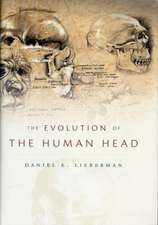Building Babies: Primate Development in Proximate and Ultimate Perspective: Developments in Primatology: Progress and Prospects, cartea 37
Editat de Kathryn B.H. Clancy, Katie Hinde, Julienne N. Rutherforden Limba Engleză Paperback – 19 sep 2014
Building Babies features multi- and trans-disciplinary research approaches to primate developmental trajectories and is particularly useful for researchers and instructors in anthropology, animal behavior, psychology, and evolutionary biology. This book also serves as a supplement to upper-level undergraduate courses or graduate seminars on primate life history and development. In these contexts, the book provides exposure to a wide range of methodological and theoretical perspectives on developmental trajectories and models how researchers might productively integrate such approaches into their own work.
| Toate formatele și edițiile | Preț | Express |
|---|---|---|
| Paperback (1) | 956.33 lei 6-8 săpt. | |
| Springer – 19 sep 2014 | 956.33 lei 6-8 săpt. | |
| Hardback (1) | 960.61 lei 6-8 săpt. | |
| Springer – 26 aug 2012 | 960.61 lei 6-8 săpt. |
Din seria Developments in Primatology: Progress and Prospects
- 20%
 Preț: 571.31 lei
Preț: 571.31 lei - 18%
 Preț: 1216.65 lei
Preț: 1216.65 lei - 19%
 Preț: 578.66 lei
Preț: 578.66 lei - 18%
 Preț: 956.69 lei
Preț: 956.69 lei - 18%
 Preț: 948.92 lei
Preț: 948.92 lei - 18%
 Preț: 948.92 lei
Preț: 948.92 lei - 18%
 Preț: 945.79 lei
Preț: 945.79 lei - 18%
 Preț: 962.66 lei
Preț: 962.66 lei - 18%
 Preț: 1664.43 lei
Preț: 1664.43 lei - 18%
 Preț: 1224.54 lei
Preț: 1224.54 lei - 24%
 Preț: 826.25 lei
Preț: 826.25 lei - 24%
 Preț: 802.74 lei
Preț: 802.74 lei - 18%
 Preț: 1562.94 lei
Preț: 1562.94 lei - 18%
 Preț: 950.21 lei
Preț: 950.21 lei - 18%
 Preț: 943.73 lei
Preț: 943.73 lei - 18%
 Preț: 1549.67 lei
Preț: 1549.67 lei - 18%
 Preț: 1248.20 lei
Preț: 1248.20 lei - 18%
 Preț: 941.38 lei
Preț: 941.38 lei - 24%
 Preț: 800.85 lei
Preț: 800.85 lei - 18%
 Preț: 953.35 lei
Preț: 953.35 lei - 18%
 Preț: 1827.48 lei
Preț: 1827.48 lei - 18%
 Preț: 1214.90 lei
Preț: 1214.90 lei - 18%
 Preț: 957.62 lei
Preț: 957.62 lei - 18%
 Preț: 1231.47 lei
Preț: 1231.47 lei - 18%
 Preț: 1225.48 lei
Preț: 1225.48 lei - 5%
 Preț: 1433.83 lei
Preț: 1433.83 lei - 18%
 Preț: 1231.16 lei
Preț: 1231.16 lei - 18%
 Preț: 1226.90 lei
Preț: 1226.90 lei - 18%
 Preț: 955.25 lei
Preț: 955.25 lei - 18%
 Preț: 956.03 lei
Preț: 956.03 lei - 18%
 Preț: 1218.53 lei
Preț: 1218.53 lei - 18%
 Preț: 950.52 lei
Preț: 950.52 lei -
 Preț: 416.82 lei
Preț: 416.82 lei - 18%
 Preț: 1554.89 lei
Preț: 1554.89 lei
Preț: 956.33 lei
Preț vechi: 1166.26 lei
-18% Nou
Puncte Express: 1434
Preț estimativ în valută:
183.01€ • 190.83$ • 152.10£
183.01€ • 190.83$ • 152.10£
Carte tipărită la comandă
Livrare economică 21 martie-04 aprilie
Preluare comenzi: 021 569.72.76
Specificații
ISBN-13: 9781489990327
ISBN-10: 1489990321
Pagini: 548
Ilustrații: XIV, 534 p.
Dimensiuni: 155 x 235 x 29 mm
Greutate: 0.76 kg
Ediția:2013
Editura: Springer
Colecția Springer
Seria Developments in Primatology: Progress and Prospects
Locul publicării:New York, NY, United States
ISBN-10: 1489990321
Pagini: 548
Ilustrații: XIV, 534 p.
Dimensiuni: 155 x 235 x 29 mm
Greutate: 0.76 kg
Ediția:2013
Editura: Springer
Colecția Springer
Seria Developments in Primatology: Progress and Prospects
Locul publicării:New York, NY, United States
Public țintă
GraduateCuprins
Preface.- I. CONCEPTION & PREGNANCY.- 1. Inflammation, reproduction, and the Goldilocks Principle.- 2. The primate placenta as an agent of developmental and health trajectories across the lifecourse.- 3. Placental development, evolution, and epigenetics of primate pregnancies.- 4. Nutritional ecology and reproductive output in female chimpanzees (Pan troglodytes): variation among and within populations.- II. FROM PRE- TO POST-NATAL LIFE.- 5. Prenatal androgens affect development and behavior in primates.- 6. Navigating transitions in HPA function from pregnancy through lactation: implications for maternal health and infant brain development.- 7. Genome-environment coordination in neurobehavioral development.- 8. Building Marmoset Babies: Trade-offs and Cutting Bait.- III. MILK: COMPLETE NUTRITION FOR THE INFANT.- 9. Lactational programming: mother?s milk predicts infant behavior and temperament.- 10. Do bigger brains mean better milk? .- 11. Infant gut microbiota: developmental influences and health outcomes.- IV. MOTHERS AND INFANTS: THE FIRST SOCIAL RELATIONSHIP.- 12. Maternal influences on social and neural development in rhesus monkeys.- 13. Behavioral Response of Mothers and Infants to Variation in Maternal Condition: Adaptation, Compensation and Resilience.- 14. The role of mothers in the development of tool-use in chimpanzees.- V. THE EXPANDING SOCIAL NETWORK.- 15. Reproductive strategies and infant care in the Malagasy primates.- 16. When dads help: male behavioral care during primate infant development.- 17. Ontogeny of social behavior in the genus Cebus and the application of an integrative framework for examining plasticity and complexity in evolution.- VI. TRANSITIONS TO JUVENILITY AND REPRODUCTIVE MATURITY.- 18. Identifying proximate and ultimate causation in the development of primate sex-typed social behavior.- 19. Future adults or old children? Integrating life history frameworks for understanding primate positional patterns.- 20. Quantitative genetic perspectives female macaque life histories: heritability, plasticity, and trade-offs.- 21. Cultural evolution and human reproductive behavior.- CONCLUSION 22. The ontogeny of investigating primate ontogeny.
Recenzii
From the reviews:
“The volume contains an impressive collection of contributions by over 30 authors. … It is a book that will be of great value to a wide range of researchers and students in primatology, reproductive physiology, behavior, and evolutionary biology in general. The concluding chapter by Robert D. Martin is a real gem. … He identifies a number of paradoxes and unresolved issues. This final chapter is both an excellent place to begin reading Building babies, and a starting point for future research on the topic.” (John G. Fleagle, The Quarterly Review of Biology, Vol. 88 (2), June, 2013)
“This exciting collection brings multiple perspectives to the challenge of understanding human and nonhuman primate development. … The importance of early life experiences and social relationships in shaping primate development and the explanatory power of an evolutionary perspective … are themes that run through the book. … Chapters draw on data from laboratory investigations, captive studies, and/or research on wild-living populations and highlight the insights that are gained when diverse approaches are used. Summing Up: Highly recommended. Upper-division undergraduates and above.” (S. Stinson, Choice, Vol. 50 (7), March, 2013)
“The volume contains an impressive collection of contributions by over 30 authors. … It is a book that will be of great value to a wide range of researchers and students in primatology, reproductive physiology, behavior, and evolutionary biology in general. The concluding chapter by Robert D. Martin is a real gem. … He identifies a number of paradoxes and unresolved issues. This final chapter is both an excellent place to begin reading Building babies, and a starting point for future research on the topic.” (John G. Fleagle, The Quarterly Review of Biology, Vol. 88 (2), June, 2013)
“This exciting collection brings multiple perspectives to the challenge of understanding human and nonhuman primate development. … The importance of early life experiences and social relationships in shaping primate development and the explanatory power of an evolutionary perspective … are themes that run through the book. … Chapters draw on data from laboratory investigations, captive studies, and/or research on wild-living populations and highlight the insights that are gained when diverse approaches are used. Summing Up: Highly recommended. Upper-division undergraduates and above.” (S. Stinson, Choice, Vol. 50 (7), March, 2013)
Textul de pe ultima copertă
The ontogeny of each individual contributes to the physical, physiological, cognitive, neurobiological, and behavioral capacity to manage the complex social relationships and diverse foraging tasks that characterize the primate order. For these reasons Building Babies explores the dynamic multigenerational processes of primate development. The book is organized thematically along the developmental trajectory:conception, pregnancy, lactation, the mother-infant dyad, broader social relationships, and transitions to independence. In this volume, the authors showcase the myriad approaches to understanding primate developmental trajectories from both proximate and ultimate perspectives. These collected chapters provide insights from experimental manipulations in captive settings to long-term observations of wild-living populations and consider levels of analysis from molecule to organism to social group to taxon. Strepsirrhines, New World monkeys, Old World monkeys, apes, and humans are all well-represented. Contributions by anthropologists, microbiologists, psychologists, population geneticists, and other primate experts provide Building Babies a uniquely diverse voice.
Building Babies features multi- and trans-disciplinary research approaches to primate developmental trajectories and is particularly useful for researchers and instructors in anthropology, animal behavior, psychology, and evolutionary biology. This book also serves as a supplement to upper-level undergraduate courses or graduate seminars on primate life history and development. In these contexts, the book provides exposure to a wide range of methodological and theoretical perspectives on developmental trajectories and models how researchers might productively integrate such approaches into their own work.
Building Babies features multi- and trans-disciplinary research approaches to primate developmental trajectories and is particularly useful for researchers and instructors in anthropology, animal behavior, psychology, and evolutionary biology. This book also serves as a supplement to upper-level undergraduate courses or graduate seminars on primate life history and development. In these contexts, the book provides exposure to a wide range of methodological and theoretical perspectives on developmental trajectories and models how researchers might productively integrate such approaches into their own work.
Caracteristici
Covers the mechanisms, function, and evolution of primate development from conception through pregnancyand lactation into dependence Provides exposure to a wide range of methodological and theoretical perspectives on developmental trajectories Models how researchers might productively integrate these different perspectives into their own work










